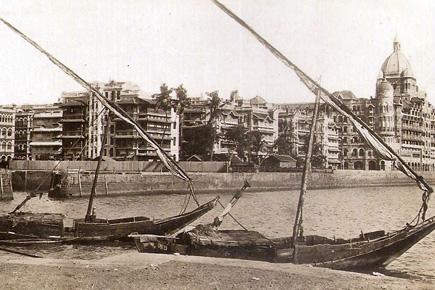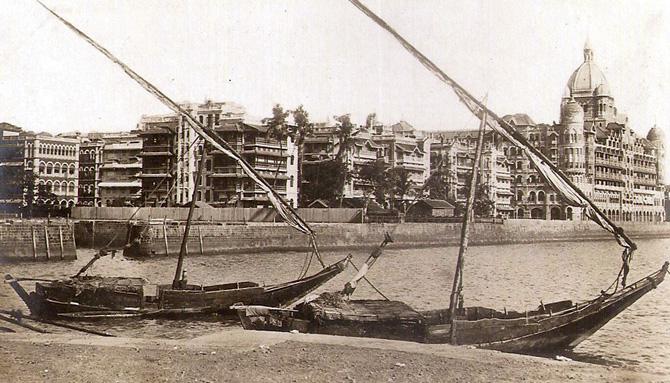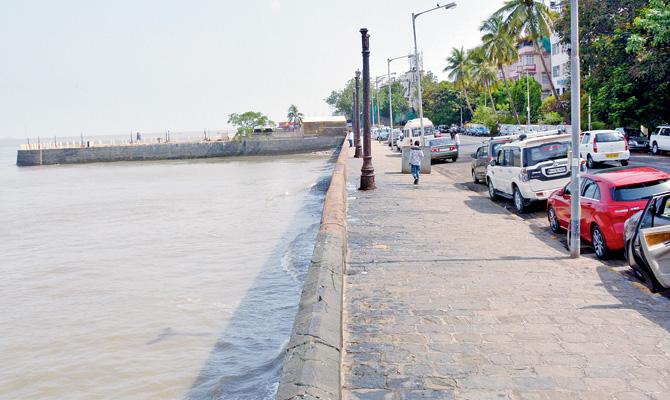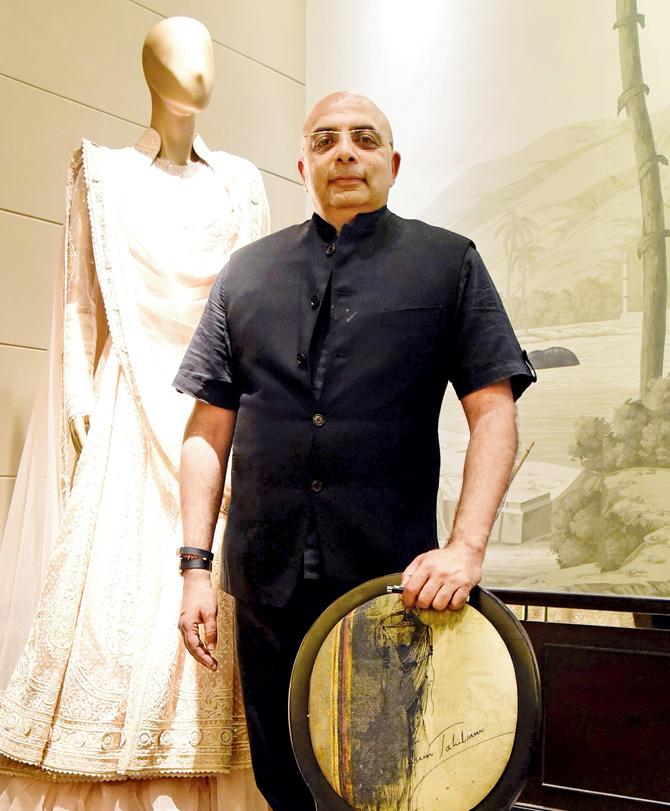Ten jewel-like buildings at Colaba's Apollo Bunder have offered more than great harbour views since 1900

An archival picture of the view of the Taj Mahal Hotel and the apartment blocks that lend the 100 metre north-south axis between the Taj and Radio Club regal charm. PIC Courtesy/Phillops Antiques

An archival picture of the view of the Taj Mahal Hotel and the apartment blocks that lend the 100 metre north-south axis between the Taj and Radio Club regal charm. PIC Courtesy/Phillops Antiques
ADVERTISEMENT
 I can't stop smiling when seeing the Gateway. That enduring symbol of Bombay has my birth date indelibly carved in yellow basalt. Thrilling as a kid to learn this was where the King and Queen of England entered town a century ago on December 2. The ride to Wittet's triumphal arch became an annual affair. Pointing out monuments and milestones en route, my parents made mine the city they had so joyfully explored as theirs.
I can't stop smiling when seeing the Gateway. That enduring symbol of Bombay has my birth date indelibly carved in yellow basalt. Thrilling as a kid to learn this was where the King and Queen of England entered town a century ago on December 2. The ride to Wittet's triumphal arch became an annual affair. Pointing out monuments and milestones en route, my parents made mine the city they had so joyfully explored as theirs.
It's my mother's favourite promenade I stroll this time: 10 apartment blocks lending the 100-metre north-south axis between the Taj and Radio Club a luminous glow. With large windows overlooking the misty Uran horizon hills, these homes rose at the dawn of the 1900s along Apollo Bunder or Strand Road. Rechristened Prem Ramchandani Marg to honour the braveheart fatally hit flying a Mystere in the 1965 Indo-Pak War.

Far south, the strip is signed off by the lovely pier-embracing-bay location the Radio Club boasts
Apollo Bunder proved the Bombay Port Trust's finest reclamation scheme leasing 99-year estates. Bunder meaning "port", the word Apollo is supposed to derive from the Palla fish sold at the spot – corrupted to the Portuguese "Pollem", it finally emerged "Apollo".
The gem kicking off the Edwardian-Art Deco stretch is Northcote Nursing Home, constructed in 1902. Named for Lord Northcote, Governor of Bombay from 1900 to 1903, this English guesthouse was converted into a multi-specialty facility by one Mr Adenwala. Plastic surgeon Dr Sam Mahaluxmivala joined in 1961, tending trauma and cosmetic cases. "Celebrities would register under assumed names, most commonly Shah!" he laughs. His huge contribution is Northcote's art collection: every room and landing boasted canvases by MF Husain, KH Ara, Shiavax Chavda, Homi Patel and Lalitha Lajmi among others. When the nursing home closed in 2007, the works were raffled. Dr Mahaluxmivala's hall hangs Beginning of a Kathakali, one of just three 6x4 feet canvases Husain signed in Malayalam.

Beautiful red champa trees in bloom at the gates of Belha Court, the only stone residential building along this strip. Pic/Shadab Khan
Next up, The Anchorage, recipient of the 1989 Heritage Society Award, has royal links. The family of Rajkumari Urmila Devi of Kotda Sangani, daughter of Vijaya Devi, Princess of Mysore, owned the building, where Urmila Devi was born in January 1947. "Through the '30s, this was the winter home of my grandfather, the Yuvaraja of Mysore, Kanteerava Narasimharaja Wadiyar, younger brother of Maharaja Krishnaraja Wadiyar IV who ruled from 1902," she says in a phone conversation. "Mother loved visiting The Anchorage. My grandmother, Yuvarani of Mysore, from a relatively landlocked state, enjoyed the sea and shopping for silver in the vicinity." In 1940, the Yuvaraja returned unwell from a foreign trip to The Anchorage, where he died. Nine years after, the property was sold by Urmila Devi's mother's brother, Maharaja Jayachamaraja Wadiyar.
Bharat Petroleum later acquiring The Anchorage, it was home to Tasneem Mehta, responsible for re-gifting the city the Bhau Daji Lad Museum. Her husband Vikram helming Shell India, they lived in a 4,000-square-feet flat for 10 years from 1994. "Our city's own tiny Riviera, this stretch has great scenic charm," says Mehta. As the Mumbai convenor of INTACH, she helped architect PK Das restore the Gateway.

Tarun Tahiliani
"This is home, from the pigeons to the Sea Lounge to jam sessions at Radio Club. The street was glorious, the 'image' of Bombay," exults Tarun Tahiliani. Born in Villar Ville, designed by an Italian, in which his maternal grandfather had the duplex penthouse from the 1950s, the couturier has come full circle. His flagship Ensemble store elegantly fronts this ancestral seat of wooden balconies and lattice work.
At the point Strand Road greets Henry Road, 1906-built Curzon House is where Scholar School was started in 1960 by Irishwoman MM Grant, former headmistress of Campion School. Pravin Puri informs me his father Amarnath bought the building in 1956 from Mozelle Nathan, who inherited it from her grandparents. Prossers Boarding House here was rented by the Mulchandani family from 1947.
On the facing corner, 1905 Art Deco jewel Evelyn House extends accommodation to senior marine pilots. It was named after the wife of Arthur Fosbery, chief engineer of the Port Trust. Retired BPT additional chief mechanical engineer Dilip Vishwanathan describes this as the only building on the row with a single flat per level. Though strikingly restored, its original column woodwork is lost except for the flooring. Harbour master for Bombay Port, Captain Kailash Mishra lived in Evelyn House till it turned BPT guesthouse in 1991. Having occupied its top floor, he says, "Outside is a living sea, lit by sailboats, bustling with activity, unlike the dead water around Governor's Beach."
I reach Mark Haven deep in déjà vu, remembering cosy Christmas parties with Bombay Local History Society members in Nuvart Mehta's terrace flat. Chowkidar Padam Singh, who has been here for 45 years, gallantly shields me from slight drizzle with a big umbrella. Armenian émigré Nuvart Parseghian from Istanbul was posted to Bombay in 1952 by the USIS education department. Marrying a Parsi colleague, she fiercely cared for the city to the end of her 100 years. "Nuvart was at Colaba police station or the municipal office every week," says her neighbour Gul Kripalani.
David daSilva, grandson of physician Clement Pereira who built Mark Haven, confirms his grandparents named the property after their son Mark. Another apartment block behind it, Joyeden, was for two of their daughters, Joy and Edna. David's mother, Edna, married solicitor and violin virtuoso Vere daSilva, who played in the Dorian Quartet, post-Independence Bombay's first strings ensemble, with George Lester, Terence Fernandes and Keki Mehta. In 1957, he memorably conducted the Bombay City Orchestra with African American contralto Marian Anderson at Regal Theatre.
"I was fascinated by the mud track along the water opposite and a fire hydrant within our garden walls before the 1970s claimed half the grounds for street broadening," says daSilva. Across Mark Haven, his father took sailing up the harbour adman friend Sylvester daCunha, who recalls, "Vere really taught me to read the wind."
Breathtaking red champa trees flower at both gates of Belha Court, the sole stone residential structure on the waterfront. They lead to a facade uniquely blending Early Edwardian and Art Deco elements. Ringed by rose gardens, this was Cecily Court till 1938 when it transferred, from an Englishman and his wife Cecily, to the Nawab and Begum of Belha. Their grandson Jaffar Imam, scion of the Kamadhia darbar, explains block to block architectural shifts from Edwardian to Art Deco. "Driven to St Mary's School in a 1920s Dodge, I loved the view, the quietude making this street most beautiful," he says. "The years have brought traffic, beggars and urchins. At least there is peace without hawkers."
After Belha Court, three hotels loom in a continuous loop. On the patio of Sea Palace Hotel, we watch circling gulls as Srichand Chhabria narrates his father's story. Doulatram Chhabria purchased the property in 1941 from Gourdon & Co. which ran Silver End Flats, a serviced apartments operation. Its location makes Sea Palace fairly popular with business travellers and backpackers. "Today, more local Indians check in because of twice as much disposable income than they used to have," Srichand reasons. "Our homely ambience has professionals on work trips return with families."
Pretty in pink Strand Hotel in Kerawalla Chambers presents Art Deco highlights after the comparatively bare walls of Sea Palace. Rustomji Nusserwanji Kerawalla got the building, which has always functioned as a hotel, in 1936, says his namesake great-grandson. Inhabited by a string of tenants, from 1960 the top pair of floors is Hotel Harbour View, owned by the Kerawallas; the ground, first and second storeys comprising Strand Hotel belong to Mulchand Lalwani & Associates.
At the cusp of Apollo Bunder and Arthur Bunder Road, 1934-built Shelleys Hotel was Lentin Court, erected by Phirozeshaw Lentin. The '70s saw it pass to Balwant Rai Selhi (Shelley is the anglicised Punjabi) whose grandson Divesh Wadhawan fills me in on some interesting hotel history. Then famous as Lentin Court Hotel managed by Otto King, a German who left during the Second World War, the continental-style bed and breakfast was entirely populated by Europeans, according to The Bombay Street Directory published by The Times of India around 1940. Recent long-staying guests included Rabbi Gavriel Holtzberg, killed in the Nariman House attack of 26/11 (he had even wanted to transform this hotel into a Chabad House) and astrologer Bejan Daruwalla, believing Room Number 8 was lucky for him. Re-sold in 2006, the property was keenly eyed for a Planet Hollywood outlet but conservationists quashed the international franchise's plan.
The Bombay Presidency Radio Club ends this strip with a mesmeric pier-embracing-bay location. Five years before the sports club opened, it aired the country's first broadcast from a low powered station operating on a 387-metre wavelength, in June 1923. This remained the only radio station till All India Radio in 1927. "In the years we were headed to freedom, those news bulletins stirred listeners, made patriots of people," says club president Premal Goragandhi. Adding that they went on to have members turned martyrs. A resident in Candy Castle nearby, Prem Ramchandani, was one of them.
Author-publisher Meher Marfatia writes fortnightly on everything that makes her love Mumbai and adore Bombay. You can reach her at mehermarfatia@gmail.com
 Subscribe today by clicking the link and stay updated with the latest news!" Click here!
Subscribe today by clicking the link and stay updated with the latest news!" Click here!






